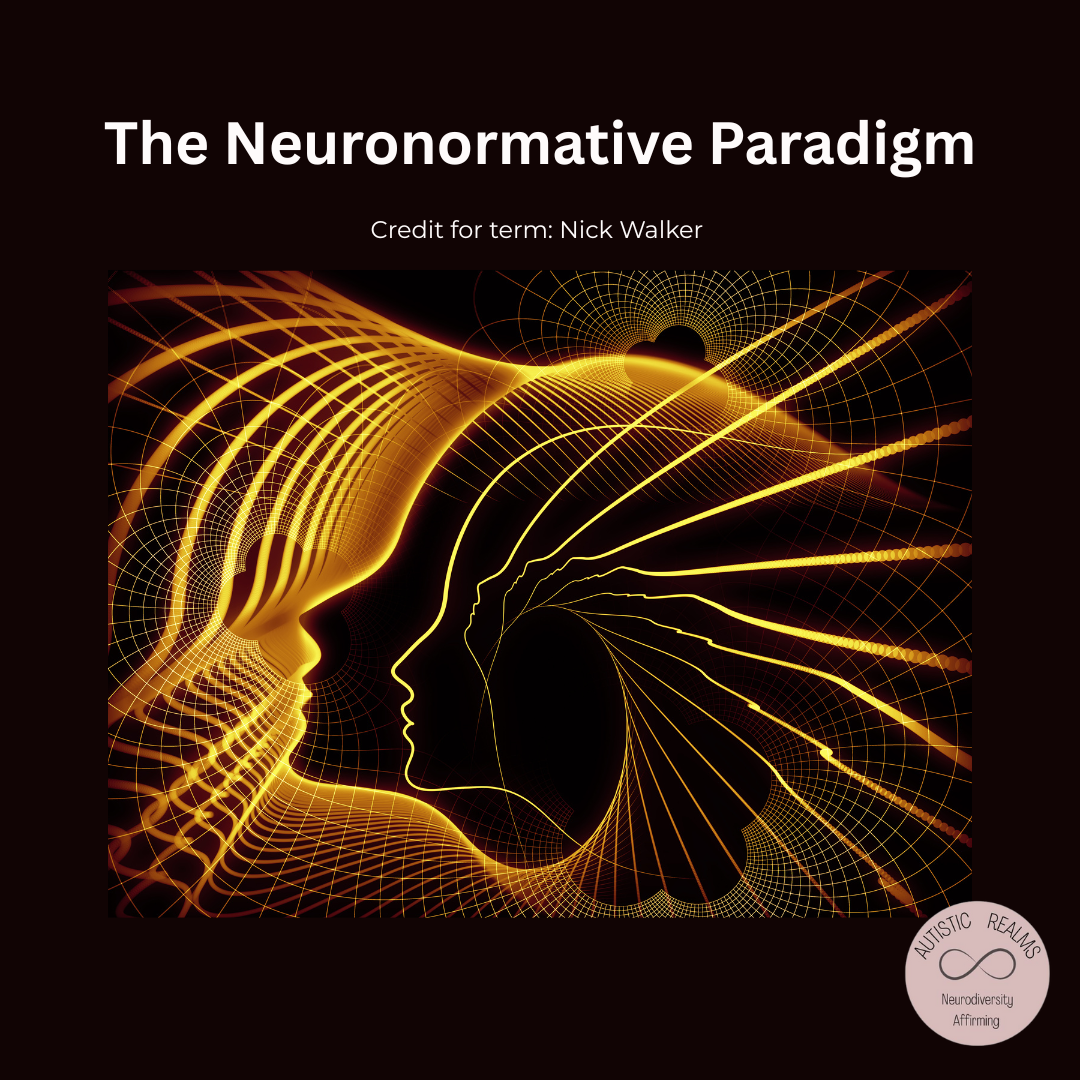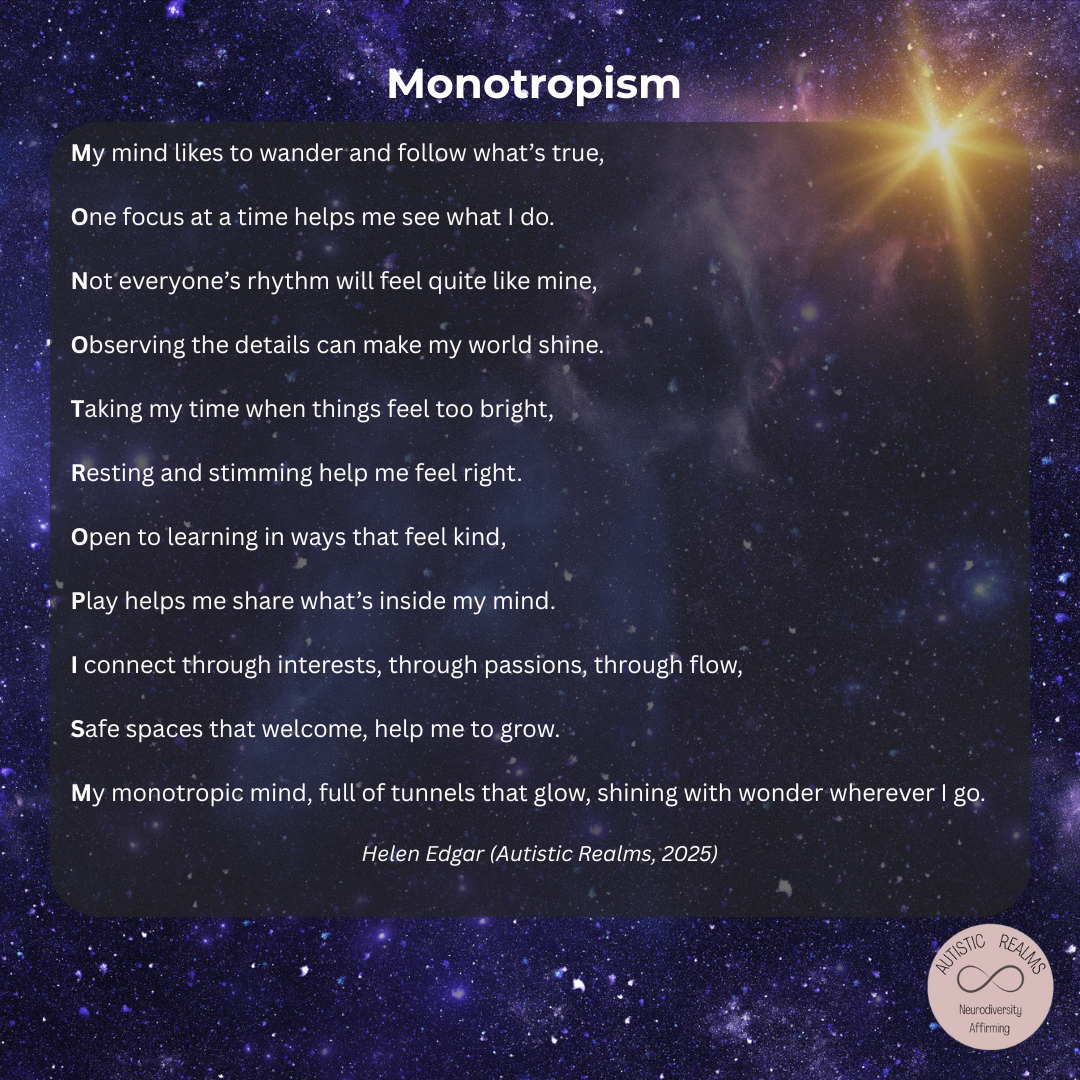Your basket is currently empty!

Going Deeper: Rest, Burnout, and Monotropic Flow
When Autistic people are in burnout, we’re often told to “rest”, to slow down, take time off and pull back from pressure.
These suggestions don’t work for me as rest doesn’t feel restful when it’s a demand and disconnected from how I naturally think, feel, and process the world as a monotropic person. When I am in burnout I tend to go deep, I worm hole into Deleuzean philosophical podcasts, I read texts that I actually don’t always understand, I dive even deeper to try and make connections and sense. It is a way of regulating, it helps me feel good, I feel immersed and restored, it gives back energy when other things feel like they strip my spoons away.
In former years I may have gone on long runs, very long runs, pushing my body and not my mind to it’s limits but my body is now tired…… Ways of resting like this are often shamed. We may be told we are a work-a-holic, indulging in pointless activities and disconnecting with ‘real life’.
For many Autistic people the type of rest that helps us isn’t about switching off, or trying to re-align with other people’s expectations of what rest ‘should’ look like. It’s about going deeper, into the things that hold meaning for us, into the flow of our interests, into the tunnels that carry us back to our temporal monotropic home. Our rest may be more sensory or related to art, crafts, lego, gaming, making slime, splashing in puddles, rearranging collections, or something else, but it is all valid how ever it looks, deep diving into things that we are passionate about helps regulate flow and can bring some joyful glimmers into a life that often feels VERY hard!
Why “rest” doesn’t always feel like rest
Burnout for Autistic people is real, complex, and often invisible due to things like interoception differences, until it hits, intensely. It can come from sensory overload, constant masking, everyday demands that chip away at our energy, and the pressure to keep up with expectations that were never designed with us in mind. When we reach burnout, when we have no more energy or spoons left to mask or push through anymore, well meaning friends often tells us to ‘rest’ and take time off work, but resting isn’t always as simple as stopping. If I can’t do the things that are pulling my attention at that time I am left really dysregulated and it prolongs and intensifies burnout.
Unstructured time can feel disorienting, especially when usual routines fall away, being told to “just relax” or “do something gentle” can feel like more pressure and another demand to mask, especially if those things don’t match how we truly regulate. Sometimes the hardest thing is figuring out how to rest in a way that actually helps you regulate your monotropic flow and needs.
Structure inside unstructured time
In burnout, we often can’t tolerate external demands, but we still need something to hold on to, a sense of structure and a rhythm that gives us coherence when everything feels scattered and chaotic. For myself, that structure often doesn’t come from schedules or to-do lists, it comes from deep immersion.
Many Autistic (and ADHD) people are monotropic, meaning our attention naturally flows toward a small number of interests at a time. When we follow those interests, we’re not just focusing, we’re making sense of the world, finding comfort, and reconnecting with who we are and our authentic needs. It can be rejuvenating and restorative spending time with your passions and leaning into sensory experiences, activities and interests that help you feel good.
In burnout, these interests can become even more important, they give us a place to go when everything else feels too much. They give us structure inside the unstructured and can help make life a bit more manageable.
Tunnelling
It can be easy to misunderstand what this looks like from the outside. When we tunnel into something , watching the same video on repeat, reading long philosophical texts, researching something niche for hours, people might think we’re avoiding life, or that we’re shutting down. Instead of seeing this as a disconnection with the world and feeling shame, I am trying to reframe it as a way of re-connecting.
Monotropic tunnelling can be a way to feel safe, to make sense of our experience, to process what’s happened in a way that feels manageable. It can be a way of caring for ourselves without needing to explain or perform. It’s a way of resting through depth, we aren’t switching off, we’re switching into something meaningful that holds space for us.
Monotropic time
Time doesn’t always move in straight lines for Autistic people. We don’t all experience time as linear or predictable. It loops, it spirals, it stretches and contracts depending on our energy, our environment, and our focus.
In burnout, time can feel strange, my days blur together, some moments drag endlessly and others disappear quickly. Trying to rest by the clock is hard and stressful. Leaning into monotropic spiral time opens up something different, it gives us permission to return to the same place again and again, to revisit, re-watch, re-read, re-iterate our thoughts and activities. It allows meaning to emerge slowly, even if it doesn’t look productive to others and you may not feel like you are making progress yourself you likely will be. We need to look at wider time frames, look back on weeks ago, years ago and it is then we may be able to see the difference in our repetition.
Reclaiming rest
For some of us, rest comes in the form of lying still, wrapped in silence under weighted blankets with fairy lights and candles burning. For others, rest may be movement, of our bodies, of thoughts, patterns, language, sounds. For many we may combine all of this and fluctuate between various states trying to get all the points on our spiky profiles aligned .
Regulation doesn’t always mean quietness or disengagement from work or traditional mindfulness activities that are so often suggested by therapists. Here are a few examples of how rest might look different for Autistic/ ADHD/ Monotropic people:
- Immersing in a deep interest or sensory experience
- Stim-watching or stim- listening to something familiar over and over
- Revisiting a thoughts, questions, wanderings and half done projects
- Researching a niche topic until the world feels more coherent and you feel that ‘just right’ sensation
- Stimming and letting the rhythm bring calm and regulate flow
These aren’t distractions from rest or healing, they are rest and can help us heal, especially when they’re done on our own terms, at our own pace. Rest doesn’t have to mean stepping away from everything that matters to us. It can mean stepping more fully into it. It can mean honouring what actually restores us, even if it looks different from what others expect.
We can rest by allowing ourselves to spiral, to tunnel, to be nonlinear. To return to what we love without guilt, to make space for our bodyminds to move the way they want to move. We shouldn’t need to explain why something feels regulating, if it works, it works, and if flow feels good then embrace it!
We need to reclaim neurodivergent ways of resting from a system that doesn’t understand our rhythms. We need to create spaces where rest isn’t something separate from who we are, it’s something woven into the way we live through our in -person and on-line communities in practices such as body doubling, co-regulation and interdependent ways of being.
Embracing deep flow
Burnout can feel like everything is falling apart, but it could also be seen as a threshold , a place where we can pause, listen, and reconfigure, not to become someone else or mask to fit in, but to return to ourselves. We may need to stay in our monotropic flowy attention tunnels even longer than others expect, we may need to go deeper. We may need to let go of timelines, checklists, and expectations that don’t fit.
If you’re in burnout and feeling like conventional neuronormative based advice doesn’t work for you, you’re not failing, you’re not broken, you’re moving with a different rhythm, one that makes sense to your body, your mind, your way of being and that is valid.
Sometimes rest isn’t about pulling away, it’s about going deeper in and embracing our monotropic flow.
Latest Posts
-
Autistic Burnout – Supporting Young People At Home & School

Autistic burnout in young people is real—and recovery starts with understanding. This post offers neuroaffirming ways to spot the signs, reduce demands, and truly support. 💛 #AutisticBurnout #Neuroaffirming #Monotropism #AutisticSupport
-
Monotropic Interests and Looping Thoughts

The theory of monotropism was developed by Murray, Lawson and Lesser in their article, Attention, monotropism and the diagnostic criteria for autism (2005). Monotropism is increasingly considered to be the underlying principle behind autism and is becoming more widely recognised, especially within autistic and neurodivergent communities. Fergus Murray, in their article Me and Monotropism:…
-
Map of Monotropic Experiences

Monotropism seeks to explain Autism in terms of attention distribution and interests. OSF Preprints | Development and Validation of a Novel Self-Report Measure of Monotropism in Autistic and Non-Autistic People: The Monotropism Questionnaire This map highlights 20 common aspects of my personal monotropic experiences. How many do you experience? Where are you on the map…
-
Autistic Burnout – Supporting Young People At Home & School

Being autistic is not an illness or a disorder in itself, but being autistic can have an impact on a person’s mental and physical health. This is due to the often unmet needs of living in a world that is generally designed for the well-being of people who are not autistic. In addition, three-quarters of…
-
The Double Empathy Problem is DEEP

“The growing cracks in the thin veneer of our “civilised” economic and social operating model are impossible to ignore”, Jorn Bettin (2021). The double empathy problem (Milton, 2012) creates a gap of disconnect experienced between people due to misunderstood shared lived experiences. It is “a breakdown in reciprocity and mutual understanding that can happen between people…
-
Top 5 Neurodivergent-Informed Strategies

Top 5 Neurodivergent-Informed Strategies By Helen Edgar, Autistic Realms, June 2024. 1. Be Kind Take time to listen and be with people in meaningful ways to help bridge the Double Empathy Problem (Milton, 2012). Be embodied and listen not only to people’s words but also to their bodies and sensory systems. Be responsive to people’s…
-
Autistic Community: Connections and Becoming

Everyone seeks connection in some way or another. Connections may look different for autistic people. In line with the motto from Anna Freud’s National Autism Trainer Programme (Acceptance, Belonging and Connection), creating a sense of acceptance and belonging is likely to be more meaningful for autistic people than putting pressure on them to try and…
-
Monotropism, Autism & OCD

This blog has been inspired by Dr Jeremy Shuman’s (PsyD) presentation, ‘Neurodiversity-Affirming OCD Care‘ (August 2023), available here. Exploring similarities and differences between Autistic and OCD monotropic flow states. Can attention tunnels freeze, and thoughts get stuck? Autism research is shifting; many people are moving away from the medical deficit model and seeing the value…
-
Monotropism Questionnaire & Inner Autistic/ADHD Experiences

Post first published 28th July 2023 Over the past few weeks, there has been a sudden surge of interest in the Monotropism Questionnaire (MQ), pre-print released in June 2023 in the research paper ‘Development and Validation of a Novel Self-Report Measure of Monotropism in Autistic and Non-Autistic People: The Monotropism Questionnaire.‘ by Garau, V., Murray,…
-
Penguin Pebbling: An Autistic Love Language

Penguin Pebbling is a neurodivergent way of showing you care, like sharing a meme or twig or pretty stone to say “I’m thinking of you,” inspired by penguins who gift pebbles to those they care about.
-
The Neuronormative Paradigm: Naming The Systems That Harm

The Neuronormative Paradigm, conceptualised by Nick Walker, names the systems that define and enforce what society considers normal. This exploration piece contrasts the neuronormative paradigm with the neurodiversity paradigm, which recognises all ways of being as vital to human diversity.
-
Monotropism: A Poem

A poem about monotropism for children, young people, families and educators to open conversations about Autistic & ADHD experiences.
-
Understanding the Double Empathy Problem: A Guide For Autistic People & Families

FREE Neuro-Affirming Communication & Sensory Passport + Training Support Autistic people through better understanding of communication, sensory needs & double empathy.













